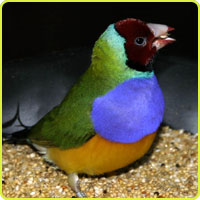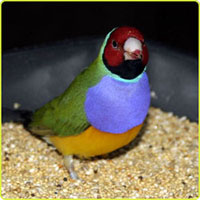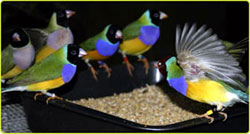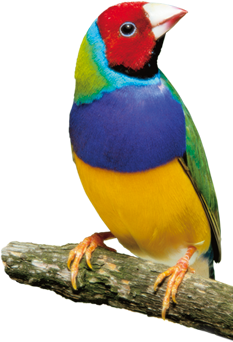Articles
A Natural Beauty
The Mareeba Tropical Savanna and Wetland Reserve Gouldian Finch (Erythrura gouldiae) Reintroduction Program - contact: Tim Nevard, Founder, Mareeba Wetland Foundation, PO Box 175, Mareeba, Queensland 4880, Australia. info@mareebawetlands.com
 The multi-coloured Gouldian Finch, a 'jewel' of the Australian tropical savannas has continued to decline in the wild across its northern Australian range for the past 50 years, due to the complex interaction of habitat loss, changing burning regimes and overgrazing by cattle, plus introduced disease. It is now rarer in the wild than the Tiger!
The multi-coloured Gouldian Finch, a 'jewel' of the Australian tropical savannas has continued to decline in the wild across its northern Australian range for the past 50 years, due to the complex interaction of habitat loss, changing burning regimes and overgrazing by cattle, plus introduced disease. It is now rarer in the wild than the Tiger!
In order to reverse this catastrophic decline, all of these factors must first be put right. An hour west of Cairns in Tropical North Queensland, the 5,000 acre Mareeba Tropical Savanna and Wetland Reserve, lies within the former range of the Gouldian Finch (Erythrura gouldiae) and these 'jewels of the savanna' were present until 35 years ago. The Reserve is easily accessible, quintessentially Australian Outback, with savanna plains, the scent of eucalyptus and massive skies. With a record in savanna landscape restoration second to none, it is hence a perfect location for a reintroduction project
After years of planning and fundraising by the Mareeba Wetland Foundation, 2002 saw the first release of Gouldian Finches back into the wild. This initial release was undertaken as a pilot study in order to assess the release strategy and affects on the birds. This approach successfully identified a number of important factors capable of influencing the success of future releases. Although not an initial success, seven chicks were fledged in the wild from these released birds. The birds were tracked using Holohil LB-2 radio transmitters to monitor their movements and habitat use and the results were used to identify the strategy for our second release in May 2003.
Amongst the findings of the pilot release, we discovered that species as diverse as Collared Sparrowhawks, Northern Quolls and Brown Tree Snakes all formed part of the guild of predators taking their toll of young and released birds.
 As a result of the 2002 pilot release, we altered our strategy in 2003. A remote release aviary was built in a location favoured by the released birds, with suitable breeding and foraging habitat. Both adults and young birds were released on the morning of May 2nd 2003. Within 30 minutes of release, the birds were feeding on the seeds of native Schizachyrium fragile grass (Fire Grass) and over the ensuing days they ranged progressively further out into the Reserve. Any potential naivety was quickly overcome with good predator awareness soon displayed. The birds were monitored, with another release of finches undertaken on the 18th August.
As a result of the 2002 pilot release, we altered our strategy in 2003. A remote release aviary was built in a location favoured by the released birds, with suitable breeding and foraging habitat. Both adults and young birds were released on the morning of May 2nd 2003. Within 30 minutes of release, the birds were feeding on the seeds of native Schizachyrium fragile grass (Fire Grass) and over the ensuing days they ranged progressively further out into the Reserve. Any potential naivety was quickly overcome with good predator awareness soon displayed. The birds were monitored, with another release of finches undertaken on the 18th August.
No release took place in 2004, as it was agreed that the strategy should be to build up numbers in the aviaries first , prior to a larger release. To this end, the Foundation raised funds to construct a second larger off site breeding aviary, which is currently being used. Plans to augment release numbers with birds from the Northern Territory are on hold owing to a disease identified in the aviary birds at the Northern Territory Wildlife Park, but it is hoped to revisit this once the NT birds have a full health clearance. In 2004 a sighting of a small flock of birds ( 4 adults and up to 16 juveniles) in an area few kilometers to the north of the Reserve (by experienced birders) raised hopes that the finches might have established a small breeding flock, but no verification has been achieved to date. However, the sighting was in ideal finch habitat, and staff at the Foundation remain hopeful!
The birds are breeding well this season, with currently a total of 79 adult birds split between the two aviaries; and the new breeding season is well underway, with already 13 fledged this year, 17 nestlings and 68 eggs being incubated. Gouldian finches being prolific breeders, it is possible for pairs to rear more than one clutch, so we are hopeful of good numbers this year, and plans will be put in place for a large release of up to 100 birds during the 2005 winter. The Foundation will involve members of the local Biboohra and Mareeba communities in assisting them to monitor the birds post release.
 The Foundation is also currently undertaking a project to re-establish native grasses important in the diet of granivorous birds such as the Gouldian Finch. Seedlings of Cockatoo Grass (Alloteropsis sp) are currently being propagated by the local DPI and seed harvested, and trial plots with early season burns have been established within the Reserve. Ongoing monitoring of this will be used to assess timing and methods of sowing and burning which will favour native grasses over introduced species. Funding for this was received from WWF/ Threatened Species Network.
The Foundation is also currently undertaking a project to re-establish native grasses important in the diet of granivorous birds such as the Gouldian Finch. Seedlings of Cockatoo Grass (Alloteropsis sp) are currently being propagated by the local DPI and seed harvested, and trial plots with early season burns have been established within the Reserve. Ongoing monitoring of this will be used to assess timing and methods of sowing and burning which will favour native grasses over introduced species. Funding for this was received from WWF/ Threatened Species Network.
This Mareeba Wetland Foundation reintroduction programme is actively supported by the Queensland Parks and Wildlife Service and James Cook University. Assistance with the programme was received from Warren Entsch MP, Member for Leichhardt, and himself a keen bird breeder; Cairns businessman George Chapman, Tim Nevard , Australian Geographic, and the Tablelands Bird Breeders Club. The project is currently supported by the National Gouldian Finch Recovery Programme, and Mars Australia Pty. Ltd and Mars New Zealand Pty. Ltd. (manufacturers of TRILL birdseed) as well as by the Foundation and volunteers..
Photos by Craig Mills- Courtesy of the Mareeba Wetland Foundation
